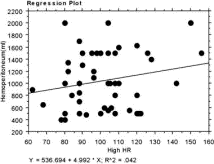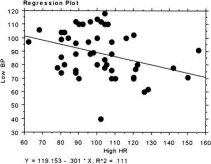Vital signs fail to correlate with hemoperitoneum from ruptured ectopic pregnancy***
Affiliations
- University of Minnesota, Hennepin County Medical Center, Minneapolis, MN
Affiliations
- University of California-Davis Medical Center, Davis, CA.
Affiliations
- University of Minnesota, Hennepin County Medical Center, Minneapolis, MN
Affiliations
- University of Minnesota, Hennepin County Medical Center, Minneapolis, MN
To view the full text, please login as a subscribed user or purchase a subscription. Click here to view the full text on ScienceDirect.

Fig. 1
Volume of hemoperitoneum (mL) v patient's lowest ED systolic blood pressure (mmHg) and regression plot.

Fig. 2
Volume of hemoperitoneum (mL) v patient's highest ED heart rate (beats/min) and regression plot.

Fig. 3
Patient's highest ED heart rate (beats/min) v lowest ED systolic blood pressure (mmHg) and regression plot.
Abstract
The objective was to determine correlation between vital signs and hemoperitoneum in ruptured ectopic pregnancy. A retrospective chart review of ectopic pregnancies at our urban county hospital between 1990 and 1998 was conducted. Fifty-one cases met inclusion criteria. Mean minimum systolic blood pressure (SBP) 89mmHg (range 40-118), mean maximum heart rate (HR) 101 beats/min (range 62-156). Mean volume of hemoperitoneum 1,050 mL (range 400-2,000 mL). Correlation between vital signs and volume of hemoperitoneum was poor (R2 = 0.04 for HR, R2 = 0.1 for SBP). Association of tachycardia with hypotension was also poor (R2 = 0.1). Extreme individual variations were observed. If surgical decisions were made on the basis of hypotension, 38% of patients could have received either inappropriate additional studies or surgical approach. Patients with normal vital signs had a 20% chance of having class IV blood loss at surgery. HR and blood pressure do not correlate well with volumes of hemoperitoneum from ruptured ectopic pregnancy. (Am J Emerg Med 2001;19:488-491. Copyright © 2001 by W.B. Saunders Company)
To access this article, please choose from the options below
Purchase access to this article
Claim Access
If you are a current subscriber with Society Membership or an Account Number, claim your access now.
Subscribe to this title
Purchase a subscription to gain access to this and all other articles in this journal.
Institutional Access
Visit ScienceDirect to see if you have access via your institution.
Related Articles
Searching for related articles..


